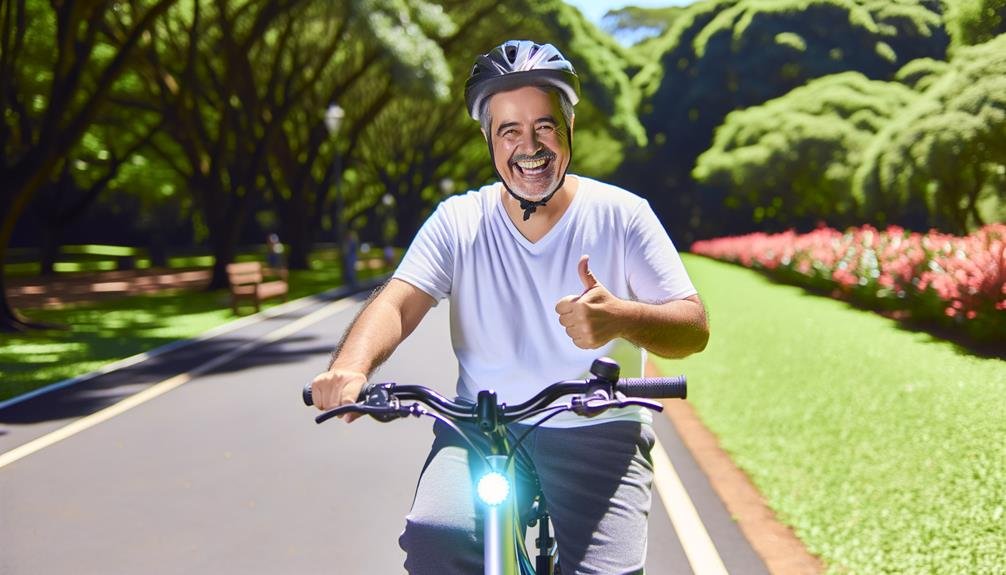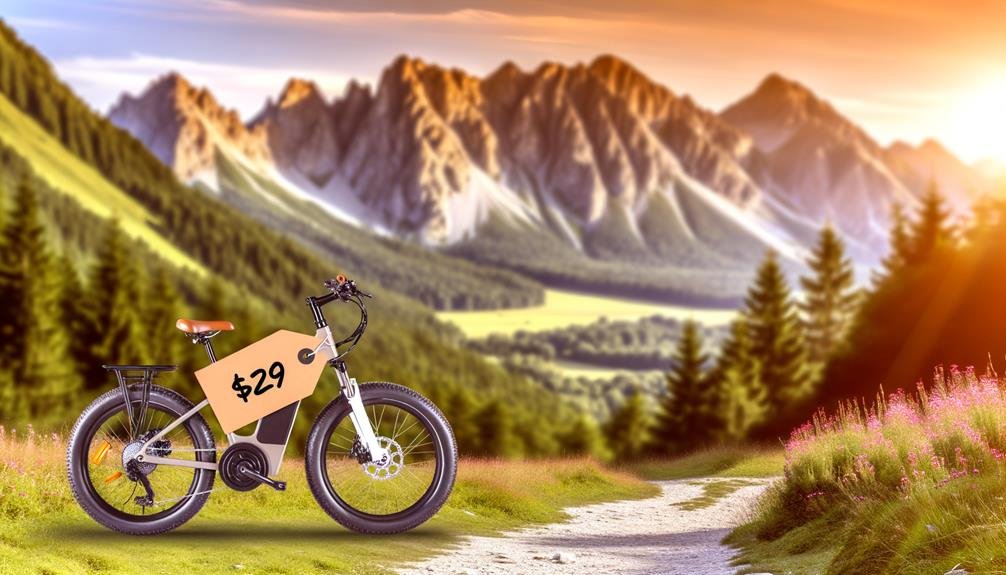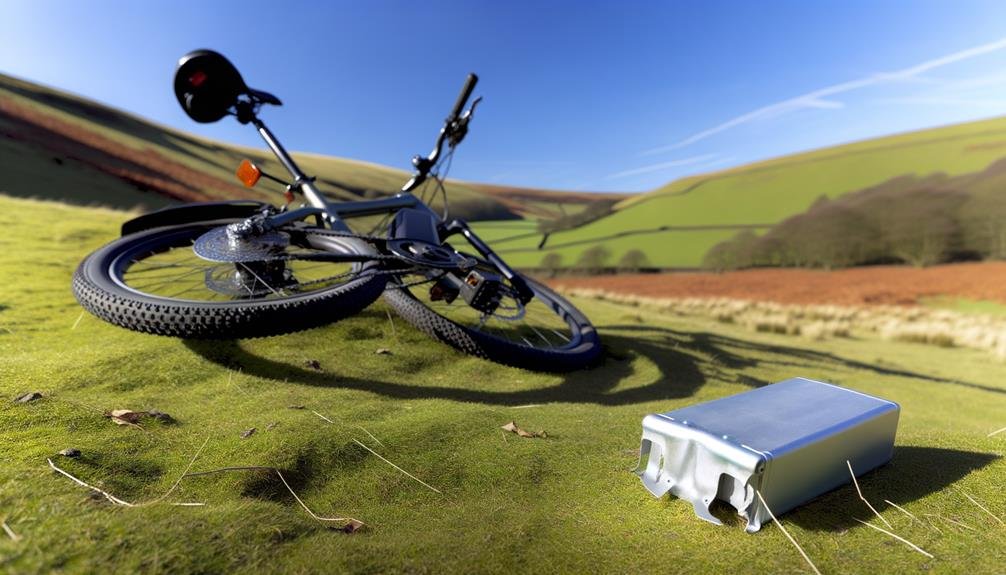Charles Miller is a veteran bike enthusiast with over 12 years of experience dealing with bikes as a mechanic. Despite immense love and expertise for...
Imagine the wind whistling by as you cruise down the road on a custom-made electric bike.
We've all probably thought about it, the idea of creating our own personalized electric bike, a perfect blend of speed, efficiency, and eco-friendliness.
It's not as far-fetched as it might sound. In fact, with the right tools, components, and a bit of technical knowledge, we can transform a conventional bicycle into an electric-powered marvel.
While it's worth noting that this isn't a project for the faint-hearted, the sense of accomplishment and the thrill of riding a bike that we've personally modified is definitely worth the effort.
So, where do we start? What components do we need? And most importantly, how do we put it all together?
Let's explore these questions and more.
Key Takeaways
- There are different types of e-bike conversion kits, including front hub, rear hub, and mid-drive motors.
- Front and rear hub motors are easy to install and suitable for flat terrains, while mid-drive motors offer better weight distribution and gear-shifting capability, making them suitable for hilly terrains.
- Factors to consider when determining power and battery needs include voltage, current, body weight, bike weight, and terrain.
- When upgrading an electric bike, it is important to select the right components such as the motor, battery, controller, and brakes, considering factors like power, efficiency, compatibility, range, and riding conditions.
Understanding Electric Bike Basics
Let's delve into the basics of electric bikes, starting with the different types of e-bike conversion kits – front hub, rear hub, and mid-drive – each offering its own perks and optimal usage depending on the terrain and bike type.
To understand electric bike basics, it's crucial to know that front and rear hub motors are easy to install and ideal for flat terrains, while mid-drive motors, though requiring intensive installation, offer better weight distribution and gear-shifting capability, making them suitable for hilly terrains. However, they're also prone to faster drivetrain wear.
For motor control, options range from throttle, cadence sensor, torque sensor, or a combination, each catering to different riding styles and preferences.
When determining power and battery needs, we consider factors such as voltage, current, body weight, bike weight, and terrain.
Battery placement and protection are also critical; options include attaching the battery to the rear rack, ensuring water resistance, and selecting the right size and capacity.
Choosing the Right Components
As we move forward in our ebike construction journey, it's time to tackle 'Choosing the Right Components'.
Our discussion will focus on three main elements: selecting the motor, choosing the battery, and picking the controller.
Each component plays a crucial role in the function and efficiency of your ebike, so we'll need to consider technical specifications, individual requirements, and personal preferences.
Selecting the Motor
To select the right motor for our electric bike, we need to weigh the pros and cons of front hub, rear hub, and mid-drive motors, taking into account our specific riding needs and the terrain we'll be traversing.
A front hub motor is simpler to install, but might affect handling due to its front wheel location.
A rear hub motor, placed in the rear wheel, offers better traction and control, ideal for steep terrains.
The mid-drive motor, mounted at the bottom bracket, offers superior balance and efficiency by leveraging the bike's gears.
Motor selection is critical, as it directly influences our ride's power, efficiency, and control. Remember, it's not just about speed, but comfort, safety, and the joy of belonging to the e-bike community.
Choosing the Battery
Having selected the perfect motor for our e-bike, we now turn our attention to another vital component – the battery. The battery's power is crucial in determining the range of our e-bike, so choosing the battery wisely is of utmost importance.
Here's a quick guide to help you understand how much battery you might need:
| Desired Range | Battery Option | Price |
|---|---|---|
| Short | Cheapest Battery | $25 |
| Medium | Mid-Range Battery | $30 – $35 |
| Long | Expensive Battery | $57 |
Picking the Controller
Diving into the specifics, we need to pick the right controller, keeping in mind the type of motor we've chosen, as this directly impacts the compatibility and performance of our e-bike.
- Check the controller's voltage and current ratings to ensure it matches our battery and motor. This ensures optimal power and range.
- Look for added features like regenerative braking and adjustable power settings to customize our e-bike's performance.
- Ensure the controller syncs with our chosen throttle or sensor system for seamless control.
Selecting an Appropriate Motor
In building an electric bike, the motor selection significantly impacts the functionality and performance of the e-bike. To make an informed decision, we'll first need to comprehend motor specifications, including factors such as voltage, current, and compatibility.
We'll then guide you through choosing the right motor type. This involves considering options like hub motors, mid-drive motors, and geared motors. Each type has its own advantages and considerations, so it's important to understand their differences before making a choice.
Finally, we'll detail the motor installation process. This includes steps such as mounting the motor to the bike frame, connecting the wiring, and ensuring proper alignment. Following these instructions will help ensure a successful and reliable motor installation.
Understanding Motor Specifications
To select the appropriate motor for your electric bike conversion, it's critical we first understand the different motor specifications. Consider factors such as the type of ebike conversion kit, motor control options, power and battery needs, and battery placement.
- Ebike Conversion Kit: Your selection depends on your bike model and riding terrain. A mountain bike, for example, might benefit from a mid-drive motor for better weight distribution.
- Motor Control: Throttle, cadence sensor, torque sensor, or a combination are all options. Your personal riding style will dictate the best choice.
- Power and Battery: Consider your body weight and riding terrain to determine voltage and current needs. Battery placement should also be given careful thought.
Understanding these specifications will ensure an optimal motor selection.
Choosing Motor Type
Having grasped the various motor specifications, we're now ready to tackle the task of selecting the appropriate motor for our electric bike conversion.
For mountain bike conversions, we opt for mid-drive motors. They're preferred for hilly trails and off-road conditions as they provide better weight distribution and traction.
Considering control options, we choose between throttle, cadence sensor, and torque sensor, which are primarily based on our riding style and preferences.
We must focus on voltage, current, and personal needs to determine the power and battery requirements.
For cost-effective options, consider converting a cheap, old bicycle. We could also purchase motors and controllers from rental e-bikes, which is a smart way to save money while acquiring quality components.
Motor Installation Process
After careful analysis of ebike motors, we're ready to delve into the motor installation process, starting with the crucial task of selecting an appropriate motor that matches our riding needs and the terrain we'll be tackling.
Here's how we'll proceed:
- We'll research the different types of motors, like hub and mid-drive motors, ensuring we choose the one that best suits our electric bike.
- We'll consider key factors such as power output, weight, and compatibility with our bike.
- We'll evaluate the installation process for each motor type, making sure it aligns with our technical skills and available tools.
Power and Battery Requirements
When planning our power and battery needs for an electric bike, it's crucial to take into account factors like body weight, bike weight, and pedaling power. This is particularly important for mountain bike enthusiasts who often deal with challenging terrains. Our voltage setup should be in line with our riding style and terrain: 24-36 volts for casual riders and flat terrains, while 48 volts and above for those of us who prefer hills and throttle riding.
Battery longevity, measured in watt-hours, is another key consideration. We need to choose a battery size that suits our individual needs and usage. For instance, if we aim to ride several miles per day, we'll require a larger battery capacity. Moreover, we should ensure the battery is easily removable for convenience, and consider water resistance or additional protection during heavy rains.
Though motor watt ratings can initially seem useful, they can be misleading. It's advisable to focus on voltage and current instead to accurately assess power requirements. This technical approach ensures we've a precise understanding of our power needs, making us part of a community of informed, electric bike builders.
Upgrading Your Bike's Brakes
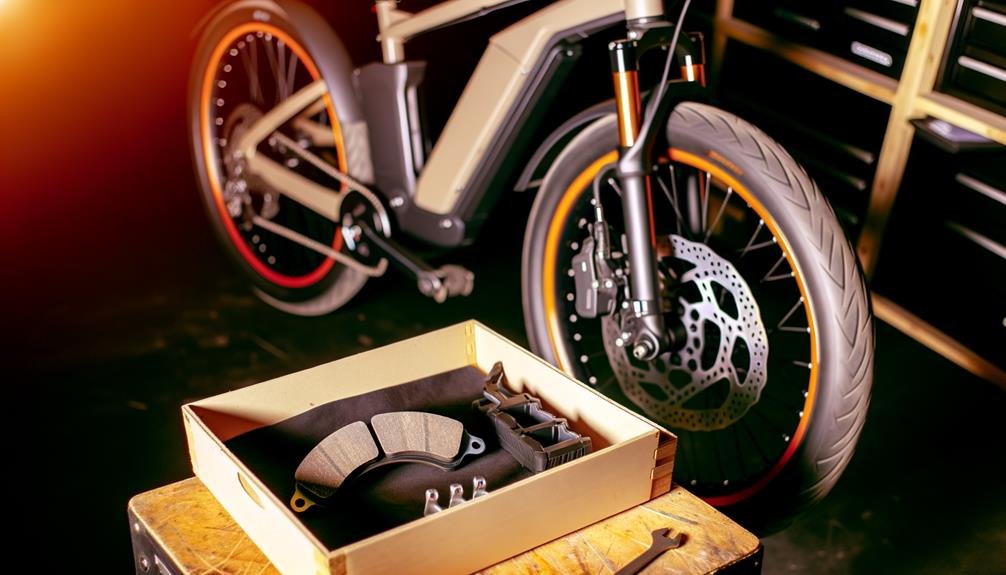
Moving on to the next crucial component, it's time we delve into upgrading our bike's brakes, a pivotal step that significantly impacts both safety and performance. With the right brakes, we'll ensure our e-bike has optimal stopping power and control, key for all types of riding.
Before we begin, it's essential we consider the type of riding we do. For regular bikes, upgrading your bike's brakes can vary from rim brakes, disc brakes, or even hydraulic brakes. Each has its benefits suited to different riding conditions.
Next, let's remember these three important factors:
- Check compatibility: Make sure the new brakes match your bike's frame and wheel size.
- Upgrade brake pads: High-quality ones offer improved stopping power and perform better in wet conditions.
- Regular maintenance: Keep your upgraded brakes in optimal condition to extend their lifespan.
If you're unsure about the installation process, we recommend seeking professional help. Improperly installed brakes can compromise your safety.
Let's ensure our electric bike isn't just about power and speed, but also about safe and enjoyable rides.
Purchasing a Conversion Kit
Diving right into our next step, we need to consider the various types of e-bike conversion kits available – front hub, rear hub, and mid-drive – each offering unique advantages tailored to our biking needs and the terrain we'll be traversing. If you're converting a mountain bike, for example, a mid-drive motor might be ideal. It allows us to use our bike's gears, offers better weight distribution for hilly terrains but be aware, it can result in faster drivetrain wear and requires a more intensive installation process.
As we explore motor control options, we must understand the benefits and drawbacks of throttle, cadence sensor, and torque sensor controls. They can greatly impact our ride, and we should choose the one that best aligns with our riding style and preferences.
To save money, consider recycling an old, inexpensive bike for conversion. We must determine our power and battery needs, focusing on factors like voltage, current, terrain, and riding habits. Remember, battery longevity is measured in watt-hours, so don't skimp on this crucial component. The right selection of motor, controller, and battery based on our budget and desired range will ensure we get the most out of our e-bike conversion.
Introduction to Swytch Kits
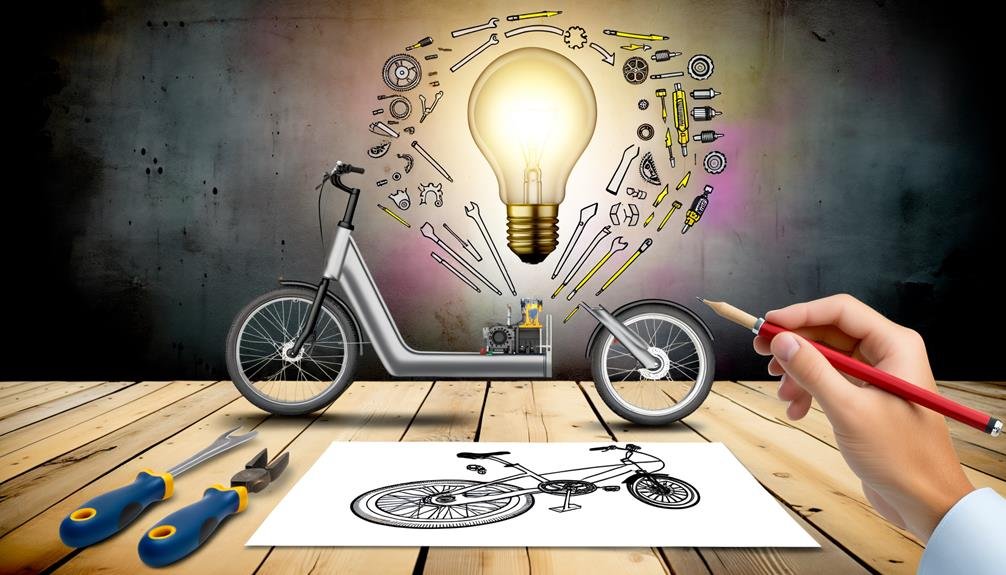
Turning our attention to Swytch kits, we find that they offer front hub, rear hub, and mid-drive conversion options, allowing us to transform traditional bikes into electric ones based on our specific needs and preferences. Converting a mountain bike or a daily commuter bike becomes a simple task with these kits, and the front wheel is typically where the magic happens.
Swytch kits provide a range of motor control options including throttle, cadence sensor, and torque sensor for a customizable riding experience. This offers us a high degree of control over our ride.
They take into consideration factors such as body weight, bike weight, and terrain when determining power and battery needs. This ensures our e-bike is tailored to our specific requirements.
The battery placement and protection in Swytch kits provide water resistance and convenience. Whether we're hitting the trails on our mountain bike or commuting to work, our e-bike's functionality won't be compromised by rain or rough terrain.
In essence, Swytch kits offer a cost-effective, environmentally friendly method to breathe new life into our old bicycles, while catering to our individual needs.
Troubleshooting Common Issues
While Swytch kits revolutionize our old bicycles and cater to our individual needs, it's essential to understand how to address common issues that may arise during their use. We've compiled a handy guide to troubleshooting common issues, whether you're using your Swytch kit on a mountain bike or a city commuter.
| Problem | Solution |
|---|---|
| Battery not charging | Check the charger and battery connectors for any damage. If possible, test with a different charger. |
| Assistance not activating | Ensure the pedal sensor is correctly installed and functioning. Also, confirm the power pack is fully charged. |
| Power pack not turning on | Double-check the wiring from the power pack to the handlebar display. Ensure the connectors are secure. |
| Motor making strange noises | Inspect the motor for any physical damage. Sometimes, loose screws or debris can cause noises. |
| Bike not accelerating | Check the throttle's operation. If the issue persists, the motor may need servicing. |
Our goal is to keep you on the road and enjoying the benefits of your electric bike. Remember, regular maintenance and early troubleshooting can prevent more serious issues from developing. We're here to help you make the most of your biking experience.
Frequently Asked Questions
Can You Build Your Own Electric Bike?
Yes, we can build our own electric bike. However, DIY challenges can arise, especially in component selection. It's crucial we understand the different types of kits, motors, and control options to ensure a successful build.
Is It Cheaper to Build or Buy an Ebike?
We've found that building an ebike can be cheaper, but DIY ebike challenges like sourcing parts and needed tools can add up. Sometimes, cost-efficient alternatives like pre-built ebikes offer better value for your money.
How Much Does It Cost to Build a Electric Bike?
We've analyzed our budget allocation and found that the cost to build an electric bike is under $150. Future upgrades and modifications aren't included in this cost analysis but can enhance our e-bike's performance.
How Fast Will a 1000w Ebike Kit Go?
We've found a 1000w ebike kit can reach speeds of 28-30 mph. However, factors such as motor efficiency, rider weight, and terrain can affect this. Remember, safety measures are crucial at high speeds.
Conclusion
So, we've journeyed through the world of electric bike building, haven't we?
We've dug into the basics, sorted out the components, powered our rides, upgraded our brakes, and tackled troubleshooting.
We've even dabbled in conversion kits and Swytch kits.
With a bit of technical know-how, precise choices, and detailed planning, we've transformed an old bike into an eco-friendly, energy-efficient machine.
Now, it's time to hit the road and test our creation.
Let's ride!

Charles Miller is a veteran bike enthusiast with over 12 years of experience dealing with bikes as a mechanic. Despite immense love and expertise for his Tacoma, he rides his Trek Ebike more. Anytime you meet him, you’ll either hear him talking about Bikes, or writing about all things bikes and cars on this blog.
More Posts
